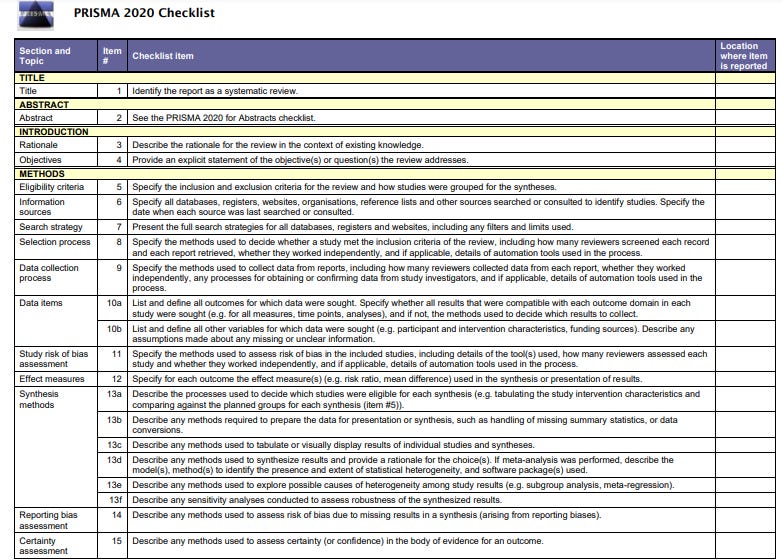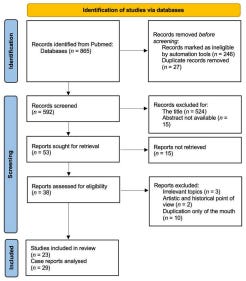What is the Preferred Reporting Items for Systematic reviews and Meta-Analyses (PRISMA) statement?
Written by Churnika Gudla
Introduction to the PRISMA Statement
The PRISMA statement is a widely endorsed reporting guideline for systematic reviews and meta-analyses. Developed to enhance the transparency and reliability of research findings, PRISMA comprises a 27-item checklist and a four-phase flow diagram. The checklist ensures that critical aspects of a review are reported, while the flow diagram illustrates the selection process of studies included in the review. By adhering to PRISMA, researchers can provide a clear, replicable, and comprehensive account of their review process, aiding readers in assessing the validity and applicability of the findings.
The Importance of PRISMA in Research
PRISMA is crucial for several reasons. Firstly, it enhances transparency, allowing readers to understand the methodology and reasoning behind the inclusion and exclusion of studies. Secondly, it promotes replicability, enabling other researchers to replicate the review and verify its results. Lastly, PRISMA helps mitigate bias by providing a structured approach to reporting, ensuring that all relevant information is disclosed. This structured approach is essential for the credibility and reliability of systematic reviews and meta-analyses, which often inform clinical guidelines and policy decisions.
Key Components of the PRISMA Checklist
The PRISMA checklist is a comprehensive tool comprising 27 items, grouped into sections such as title, abstract, introduction, methods, results, discussion, and funding. Each item addresses a specific aspect of the review, such as the rationale, objectives, eligibility criteria, search strategy, study selection, data extraction, risk of bias, and synthesis of results. For instance, item 6 requires a detailed description of the information sources and search strategy used, ensuring transparency in the identification of studies. Adhering to these items ensures a thorough and unbiased reporting of the review process.
Figure 1: A section of the PRISMA checklist that shows how
one should conduct research and format their paper (Source).
Utilizing the PRISMA Flow Diagram
The PRISMA flow diagram is a visual representation of the study selection process in a systematic review. It consists of four phases: identification, screening, eligibility, and inclusion. In the identification phase, records are gathered from various databases and sources. The screening phase involves removing duplicates and assessing titles and abstracts for relevance. During the eligibility phase, full-text articles are reviewed for inclusion criteria. Finally, the inclusion phase lists the studies included in the qualitative and quantitative synthesis. This diagram provides a clear and concise overview of the review process, enhancing the transparency and reproducibility of the research.
Figure 2: An example of a PRIMSA flow diagram that number of records identified, included, and excluded and the reasons for exclusions (Source).
PRISMA's Impact on Scientific Research
The adoption of the PRISMA statement has significantly impacted the quality and reporting of systematic reviews and meta-analyses. By providing a standardized approach, PRISMA has improved the transparency, completeness, and reliability of research reports. This, in turn, has enhanced the trustworthiness of evidence synthesis, aiding in the development of clinical guidelines and informing policy decisions. Moreover, journals and funding bodies increasingly require adherence to PRISMA, underscoring its importance in the research community. As a result, PRISMA has become an indispensable tool for researchers aiming to conduct and report high-quality systematic reviews and meta-analyses.
Sources
Mellor, Laura. “What Is PRISMA Guideline & What’s New in the 2020 Guideline?” Covidence, 5 May 2021, www.covidence.org/blog/what-is-prisma-whats-new-in-the-2020-guideline-2/.
PRISMA. “Welcome to the NEW Preferred Reporting Items for Systematic Reviews and Meta-Analyses (PRISMA) Website.” PRISMA Statement, 2021, www.prisma-statement.org/.
Trevisani, Viola, et al. “Diprosopus: A Rare Case of Craniofacial Duplication and a Systematic Review of the Literature.” Genes, vol. 14, no. 9, 1 Sept. 2023, www.mdpi.com/2073-4425/14/9/1745.
https://doi.org/10.3390/genes14091745.
Written by Churnika Gudla from MEDILOQUY



